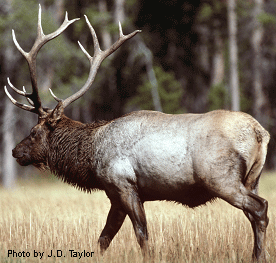
Eastern elk
Cervus canadensis canadensis
Weight
360 - 450 lbs ( 163 - 204 kg)
Height
50 - 60 inches ( 127 - 152 cm)
About Eastern elk
The Eastern elk is one of six subspecies of elk that inhabited northern and eastern United States, and southern Canada. The last Eastern elk was shot in Pennsylvania on September 1, 1877. The subspecies was declared as extinct by the United States Fish and Wildlife Service in 1880. Another subspecies of elk, the Merriam's Elk, also became extinct at roughly the same time.
Elk are primarily grazers, foraging in agricultural and natural forest openings, forest clear-cuts, rock ridges and burns. On the Precambrian Shield, elk often use abandoned fields, meadows associated with creek drainages and rocky outcrops covered with the common hair-grass. Trembling aspen, willows, red maple, staghorn sumac, red osier dogwood and eastern white cedar are frequent browse items.
During the summer elk eat twigs and leaves, as well as warm season grasses along forest edges. Open areas are used during the rut. In early winter, elk are often seen on ridges and fields, digging through snow for grass and fallen acorns. As winter progresses, elk use lower elevations associated with conifers, and consume largely woody browse. Wind-swept red oak/red maple ridges and cedar-lined frozen bodies of water are used extensively throughout the winter.
Hunting Techniques
Choice of hunting equipment
